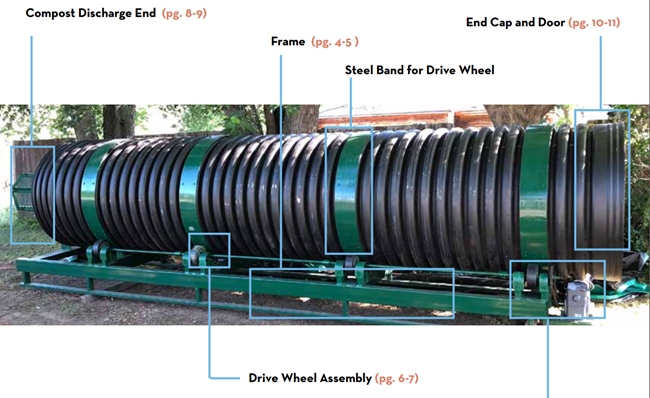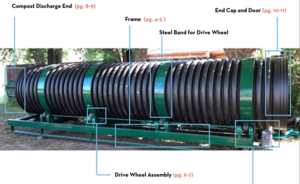
The Biochar Co-Composter

The Biochar Co-composter adapts a simple, low-cost design to handle this material and adds simple automation so that it can be easily fitted into daily farm management with little disruption.
Soil is one of the largest and most important Carbon sinks on the planet. Use of artificial fertilizers and pesticides in intensive farming has slowly degraded the health of the soil to the point where it holds little organic matter and is close to becoming lifeless. At the same time pollution and GHG emissions from fertilizer manufacture and use and mis-management of manure are causing huge damage to soil, water and the climate.
The THREE C project proposed a new management system to use Biochar as part of a circular nutrient capture system for small farms. This will help farmers to trap and preserve valuable nutrients and organic matter from animal manure and bedding and convert them to a rich compost/biochar mix that is easy to store and apply.
The Biochar Co-composter adapts a simple, low-cost design to handle this material and adds simple automation so that it can be easily fitted into daily farm management with little disruption.
The Composter serves as a tool to help:
Lower input costs and create a beneficial soil additive
Reduce GHG emissions and pollution
Help traditional family farms to work together and stay on the land
Improve food nutrition and biodiversity
The whole app has been designed to be usable both in formal education formats by educators, but also (and primarily) to be used by interested young people in their free time on their own. It includes various interactive and multimedia elements to be more engaging.
Video Titel
Conventional intensive farming has created a dependency on artificial fertilizers and chemicals by many farmers. They are now worried that converting to an organic or regenerative system using recycled nutrients will result in lower yields and financial losses.
The mechanisms by which healthy soils maintain their productivity and provide critical support for plants, and invertebrates vital to the food chain are still being explored. What is becoming clear is that the complex relationship between fungi and bacteria in the soil is badly disrupted by cultivation and use of artificial fertilizers and herbicides.
Overcoming 70 years of misinformation by the agri-chemical industry will be a difficult task, but this is best accomplished by practical trials in which groups of farmers can take part.
Groups of small livestock farmers and their organisations.
- Food buyers, nutritionists, health and wellbeing professionals.
- Politicians, Journalists and policy makers
- Educational and research institutes ( Schools, VE, AE and HE)
- Environmental organisations, community groups and NGO’s
- Construct a working prototype and locate it on a small working farm with the capacity to act as a research/demonstrator site.
- Adapt existing management practice to treat manure as a much more valuable resource.
- Integrate Biochar (if possible made locally or even on-farm) into animal diets, bedding and manure stream to be co-composted.
- Create a high value, easy to handle, versatile compost to be stored and applied to land at the optimum time of year to promote plant growth and incorporation into the soil.
- Adapt grazing techniques to ones which increase soil organic matter, soil carbon and microbial activity.
- Monitor expected input cost reductions and increase in achievable stocking densities and yields.
- Negotiate with government and agencies tom provide support to enable roll-out of system to more farmers groups.
- Using simple, low cost techniques to create a circular carbon/nutrient cycle to help dramatically reduce the input costs & impacts of traditional livestock farming.
- Developing a piece of equipment that is easy and cheap to build and maintain.
- Incorporating simple, low-cost semi-automation so the Co-Composter IVC can be left to work unattended for much of the time.
- Creating a ‘Triple A’ system: Affordable, Adaptable, Accessible
- Reduction in input costs for traditional small rural businesses
- Reduction in the impacts of manufacturing, transporting and applying artificial fertilizers.
- Healthier, deeper soils holding more Carbon, water and life than before.
- More nutritious food from small farms leaving room for wildlife and greater biodiversity.
- The system is designed to be easily replicated
- The IVC can be built and supplied in batches, or built by farmers themselves from open-source plans.
- Existing farming support networks can facilitate knowledge transfer between farmers and groups.
- Units can be operated in multiple configurations to help different sizes of farms.
If a non-profit business model is used, this can stimulate investment in the circular supply chain.

